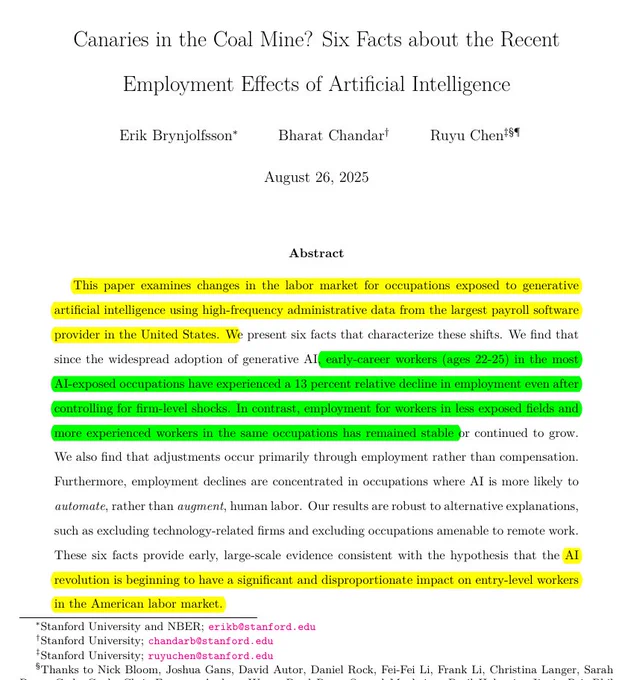💼 Finally a solid 57-page report on AI's effect on job-market from Stanford University.
THE SHIFT HAS STARTED.
Entry‑level workers in the most AI‑exposed jobs are seeing clear employment drops, while older peers and less‑exposed roles keep growing.
Though overall employment continues to grow, employment growth for young workers in particular has been stagnant.
The drop shows up mainly as fewer hires and headcount, not lower pay, and it is sharpest where AI usage looks like automation rather than collaboration.
22‑25 year olds in the most exposed jobs show a 13% relative employment decline after controls.
⚙️ The paper tracked millions of workers and boils recent AI labor effects into 6 concrete facts
The headline being entry‑level contraction in AI‑exposed occupations and muted wage movement.
AI replacing codified knowledge that juniors supply more of, than tacit knowledge that seniors accumulate.
🧵 Read on 👇
Aug 26, 2025 · 8:23 AM UTC
🧵2/n. 📊 The Data
The study uses administraest payroll processtive payroll records from ADP, which handles pay for over 25M workers, letting the authors observe monthly headcount and base salary with high granularity.
They build a balanced panel of firms present from 2021‑01 to 2025‑07, restrict to ages 18‑70 with recorded titles mapped to Standard Occupational Classification codes, and end up with 3.5M–5M workers per month in the main sample.
🧵3/n. 🧭 How AI exposure is measured
One exposure signal comes from occupational task links to GPT‑4 capabilities, aggregated to occupations, which ranks jobs by how model‑amenable their tasks look.
A second signal comes from the Anthropic Economic Index that tags millions of Claude chats by occupation tasks and classifies usage as automative or augmentative, which lets the authors separate substitute‑like usage from complement‑like usage.
🧵4/n. 📉 What changed for entry‑level in exposed jobs
Among software developers and customer service workers, headcount for ages 22‑25 falls after late 2022, with software developers down ~20% from peak while older bands keep rising.
Across occupations more broadly, the most exposed quintiles show the same split for juniors, which is why the authors call these groups canaries.
🧵5/n. 📈 What changed overall
Overall employment keeps climbing, yet the youngest cohort stalls only where exposure is high, with ages 22‑25 in the top exposure quintiles down ~6% since late 2022 while ages 35‑49 in those same jobs rise ~9%.
This explains why the total economy still looks strong even as entry‑level hiring in specific exposed tracks feels weak.
🧵6/n. 🔁 Automation vs augmentation
Where Claude usage looks automative, junior employment falls, but where usage looks augmentative, junior employment is flat to rising, which is consistent with substitution in the first case and complementarity in the second.
This pattern repeats when exposure is measured by overall Claude usage and when the lowest‑usage occupations are excluded, so the signal is not an artifact of sparse data.
🧵7/n. 🏢 Firm shocks vs worker exposure
Controlling for firm‑time shocks in a stacked Poisson event study, the most‑exposed quintiles for ages 22‑25 still show a ~12 log‑point relative employment drop versus the least‑exposed quintile, while older groups show small, non‑significant shifts.
This makes broad industry slowdowns or firm‑level hiring freezes a weak explanation for the junior‑only declines in exposed work.
🧵8/n. 💸 Wages move less than headcount
Base salaries, deflated to constant dollars, do not split cleanly by age or exposure quintile, which points to wage stickiness and faster adjustment on the hiring margin than on pay.
The authors note theory where replacing inexpert tasks can cut headcount without cutting pay if remaining tasks grow in value, which fits the small wage effects seen so far.
🧵9/n. 🧪 Robustness and scope
The same junior‑only exposure split appears after dropping computer occupations, after removing information‑sector firms, and inside both teleworkable and non‑teleworkable jobs, which weakens outsourcing or “tech winter” explanations.
Trends do not show up in earlier years or in low‑usage occupations by the Claude metric, they are strongest post‑2022 when generative AI spread, and CPS microdata is too noisy at this granularity to settle the question by itself.
Link to the full Stanford report.
digitaleconomy.stanford.edu/…




















